Mental Health Law in the United States: Legislation and Issues
VerifiedAdded on 2022/08/12
|8
|2375
|38
Report
AI Summary
This report provides an overview of mental health law in the United States, addressing the prevalence of mental health issues and the need for legislation to ensure proper care and protection for individuals with mental illnesses. It highlights the impact of mental disorders, including depression, schizophrenia, and anxiety, and emphasizes the role of the Mental Health Legislation (MHL) in regulating mental health services. The report discusses the increasing rates of mental disorders among youth, including the Children's Health Act of 2000, which reauthorizes programs aimed at improving mental health and substance misuse services for children and adolescents. It also examines the impact of adverse childhood experiences (ACEs) on mental well-being and the importance of early intervention. The report concludes by emphasizing the importance of mental health for individual success and societal contribution, and the need for continued research and support to address the challenges posed by mental illness.
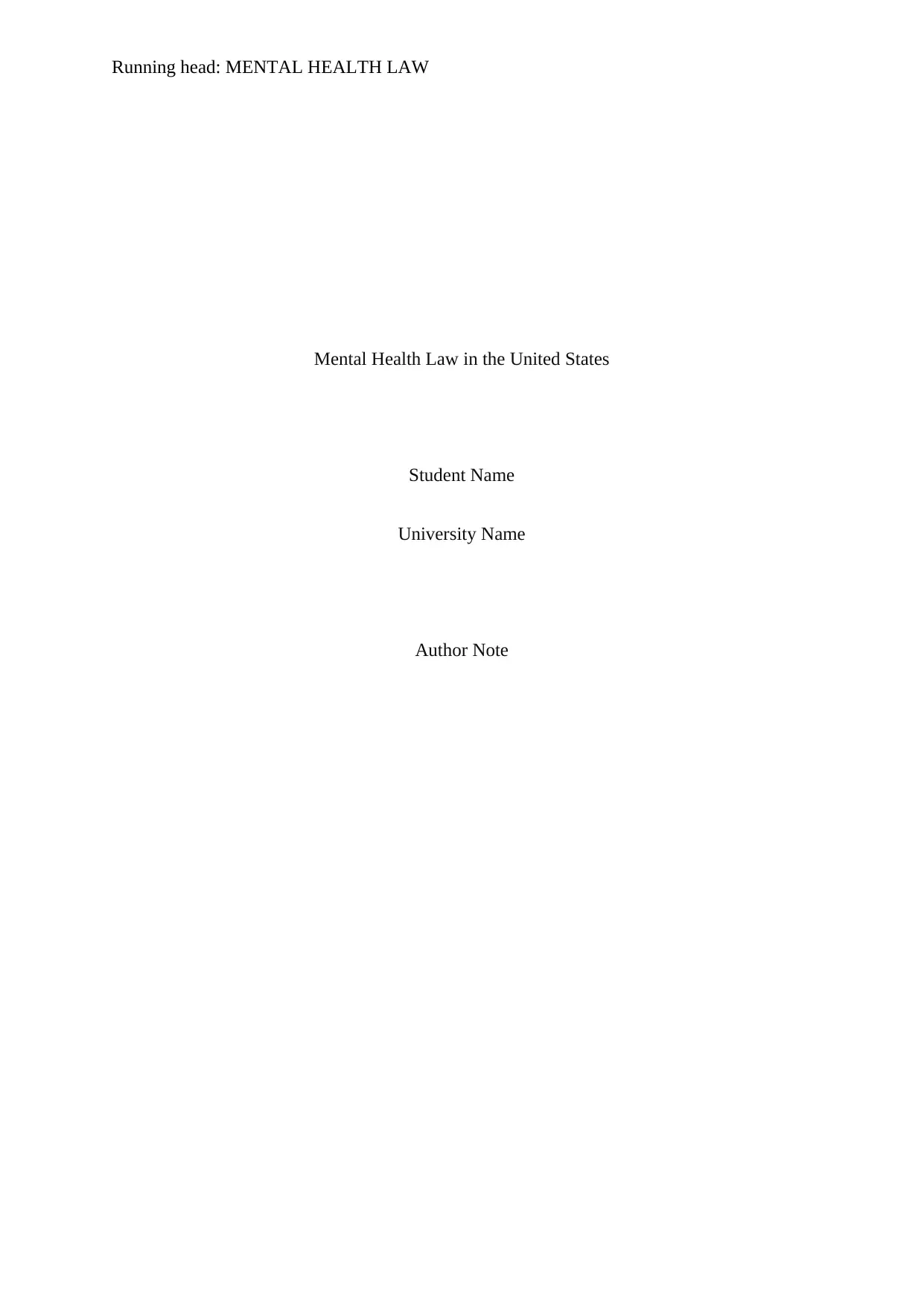
Running head: MENTAL HEALTH LAW
Mental Health Law in the United States
Student Name
University Name
Author Note
Mental Health Law in the United States
Student Name
University Name
Author Note
Paraphrase This Document
Need a fresh take? Get an instant paraphrase of this document with our AI Paraphraser
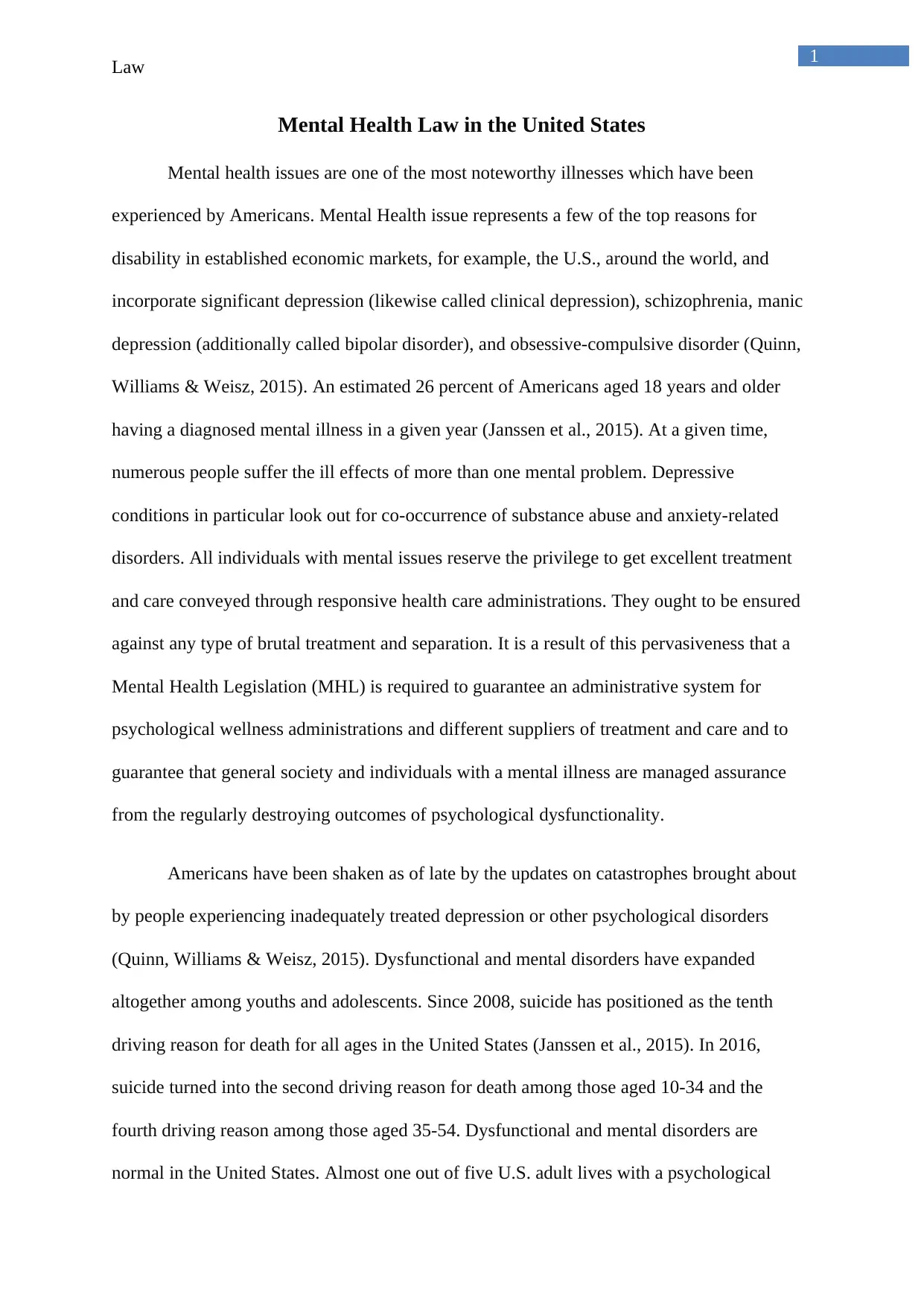
1
Law
Mental Health Law in the United States
Mental health issues are one of the most noteworthy illnesses which have been
experienced by Americans. Mental Health issue represents a few of the top reasons for
disability in established economic markets, for example, the U.S., around the world, and
incorporate significant depression (likewise called clinical depression), schizophrenia, manic
depression (additionally called bipolar disorder), and obsessive-compulsive disorder (Quinn,
Williams & Weisz, 2015). An estimated 26 percent of Americans aged 18 years and older
having a diagnosed mental illness in a given year (Janssen et al., 2015). At a given time,
numerous people suffer the ill effects of more than one mental problem. Depressive
conditions in particular look out for co-occurrence of substance abuse and anxiety-related
disorders. All individuals with mental issues reserve the privilege to get excellent treatment
and care conveyed through responsive health care administrations. They ought to be ensured
against any type of brutal treatment and separation. It is a result of this pervasiveness that a
Mental Health Legislation (MHL) is required to guarantee an administrative system for
psychological wellness administrations and different suppliers of treatment and care and to
guarantee that general society and individuals with a mental illness are managed assurance
from the regularly destroying outcomes of psychological dysfunctionality.
Americans have been shaken as of late by the updates on catastrophes brought about
by people experiencing inadequately treated depression or other psychological disorders
(Quinn, Williams & Weisz, 2015). Dysfunctional and mental disorders have expanded
altogether among youths and adolescents. Since 2008, suicide has positioned as the tenth
driving reason for death for all ages in the United States (Janssen et al., 2015). In 2016,
suicide turned into the second driving reason for death among those aged 10-34 and the
fourth driving reason among those aged 35-54. Dysfunctional and mental disorders are
normal in the United States. Almost one out of five U.S. adult lives with a psychological
Law
Mental Health Law in the United States
Mental health issues are one of the most noteworthy illnesses which have been
experienced by Americans. Mental Health issue represents a few of the top reasons for
disability in established economic markets, for example, the U.S., around the world, and
incorporate significant depression (likewise called clinical depression), schizophrenia, manic
depression (additionally called bipolar disorder), and obsessive-compulsive disorder (Quinn,
Williams & Weisz, 2015). An estimated 26 percent of Americans aged 18 years and older
having a diagnosed mental illness in a given year (Janssen et al., 2015). At a given time,
numerous people suffer the ill effects of more than one mental problem. Depressive
conditions in particular look out for co-occurrence of substance abuse and anxiety-related
disorders. All individuals with mental issues reserve the privilege to get excellent treatment
and care conveyed through responsive health care administrations. They ought to be ensured
against any type of brutal treatment and separation. It is a result of this pervasiveness that a
Mental Health Legislation (MHL) is required to guarantee an administrative system for
psychological wellness administrations and different suppliers of treatment and care and to
guarantee that general society and individuals with a mental illness are managed assurance
from the regularly destroying outcomes of psychological dysfunctionality.
Americans have been shaken as of late by the updates on catastrophes brought about
by people experiencing inadequately treated depression or other psychological disorders
(Quinn, Williams & Weisz, 2015). Dysfunctional and mental disorders have expanded
altogether among youths and adolescents. Since 2008, suicide has positioned as the tenth
driving reason for death for all ages in the United States (Janssen et al., 2015). In 2016,
suicide turned into the second driving reason for death among those aged 10-34 and the
fourth driving reason among those aged 35-54. Dysfunctional and mental disorders are
normal in the United States. Almost one out of five U.S. adult lives with a psychological
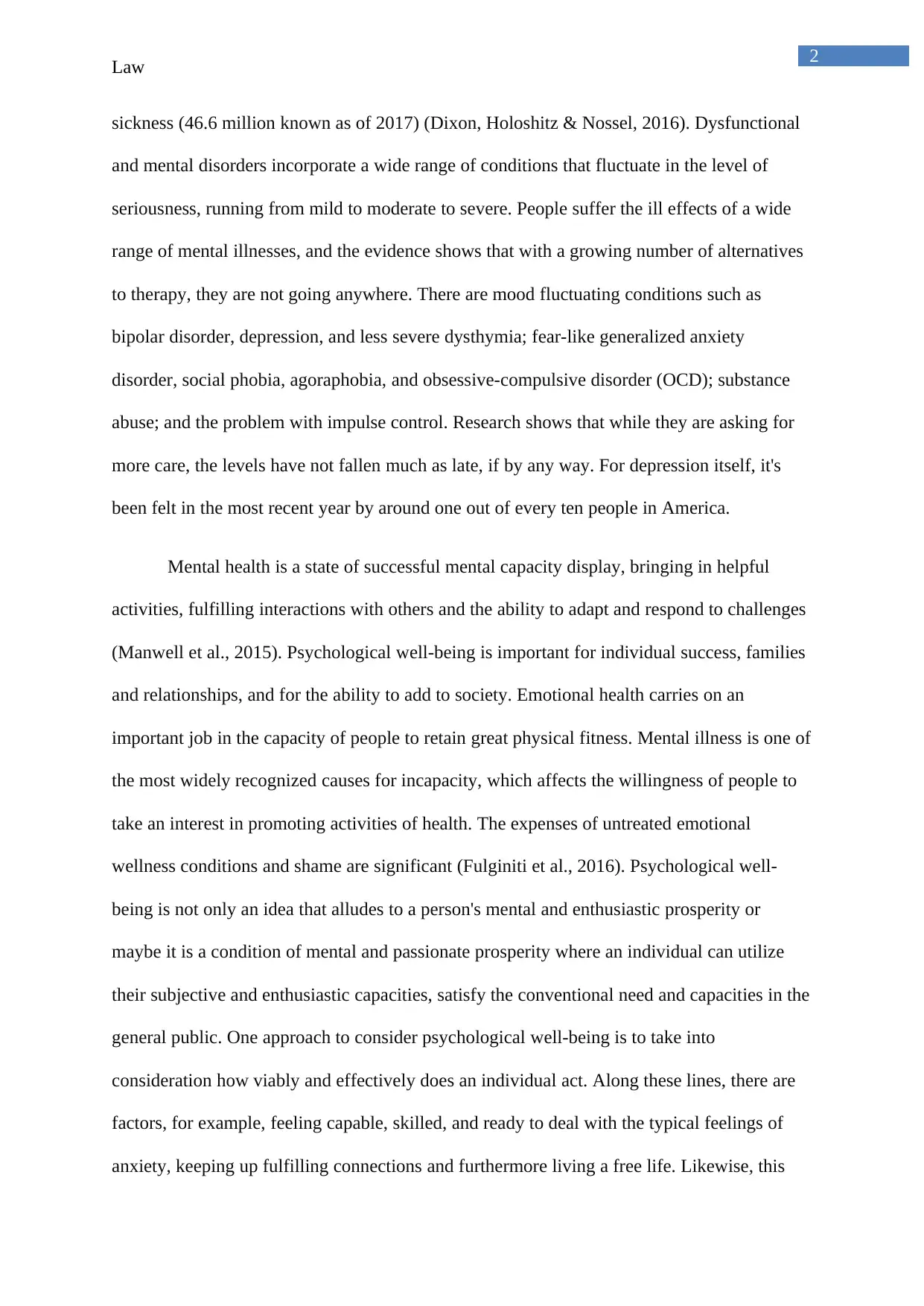
2
Law
sickness (46.6 million known as of 2017) (Dixon, Holoshitz & Nossel, 2016). Dysfunctional
and mental disorders incorporate a wide range of conditions that fluctuate in the level of
seriousness, running from mild to moderate to severe. People suffer the ill effects of a wide
range of mental illnesses, and the evidence shows that with a growing number of alternatives
to therapy, they are not going anywhere. There are mood fluctuating conditions such as
bipolar disorder, depression, and less severe dysthymia; fear-like generalized anxiety
disorder, social phobia, agoraphobia, and obsessive-compulsive disorder (OCD); substance
abuse; and the problem with impulse control. Research shows that while they are asking for
more care, the levels have not fallen much as late, if by any way. For depression itself, it's
been felt in the most recent year by around one out of every ten people in America.
Mental health is a state of successful mental capacity display, bringing in helpful
activities, fulfilling interactions with others and the ability to adapt and respond to challenges
(Manwell et al., 2015). Psychological well-being is important for individual success, families
and relationships, and for the ability to add to society. Emotional health carries on an
important job in the capacity of people to retain great physical fitness. Mental illness is one of
the most widely recognized causes for incapacity, which affects the willingness of people to
take an interest in promoting activities of health. The expenses of untreated emotional
wellness conditions and shame are significant (Fulginiti et al., 2016). Psychological well-
being is not only an idea that alludes to a person's mental and enthusiastic prosperity or
maybe it is a condition of mental and passionate prosperity where an individual can utilize
their subjective and enthusiastic capacities, satisfy the conventional need and capacities in the
general public. One approach to consider psychological well-being is to take into
consideration how viably and effectively does an individual act. Along these lines, there are
factors, for example, feeling capable, skilled, and ready to deal with the typical feelings of
anxiety, keeping up fulfilling connections and furthermore living a free life. Likewise, this
Law
sickness (46.6 million known as of 2017) (Dixon, Holoshitz & Nossel, 2016). Dysfunctional
and mental disorders incorporate a wide range of conditions that fluctuate in the level of
seriousness, running from mild to moderate to severe. People suffer the ill effects of a wide
range of mental illnesses, and the evidence shows that with a growing number of alternatives
to therapy, they are not going anywhere. There are mood fluctuating conditions such as
bipolar disorder, depression, and less severe dysthymia; fear-like generalized anxiety
disorder, social phobia, agoraphobia, and obsessive-compulsive disorder (OCD); substance
abuse; and the problem with impulse control. Research shows that while they are asking for
more care, the levels have not fallen much as late, if by any way. For depression itself, it's
been felt in the most recent year by around one out of every ten people in America.
Mental health is a state of successful mental capacity display, bringing in helpful
activities, fulfilling interactions with others and the ability to adapt and respond to challenges
(Manwell et al., 2015). Psychological well-being is important for individual success, families
and relationships, and for the ability to add to society. Emotional health carries on an
important job in the capacity of people to retain great physical fitness. Mental illness is one of
the most widely recognized causes for incapacity, which affects the willingness of people to
take an interest in promoting activities of health. The expenses of untreated emotional
wellness conditions and shame are significant (Fulginiti et al., 2016). Psychological well-
being is not only an idea that alludes to a person's mental and enthusiastic prosperity or
maybe it is a condition of mental and passionate prosperity where an individual can utilize
their subjective and enthusiastic capacities, satisfy the conventional need and capacities in the
general public. One approach to consider psychological well-being is to take into
consideration how viably and effectively does an individual act. Along these lines, there are
factors, for example, feeling capable, skilled, and ready to deal with the typical feelings of
anxiety, keeping up fulfilling connections and furthermore living a free life. Likewise, this
⊘ This is a preview!⊘
Do you want full access?
Subscribe today to unlock all pages.

Trusted by 1+ million students worldwide
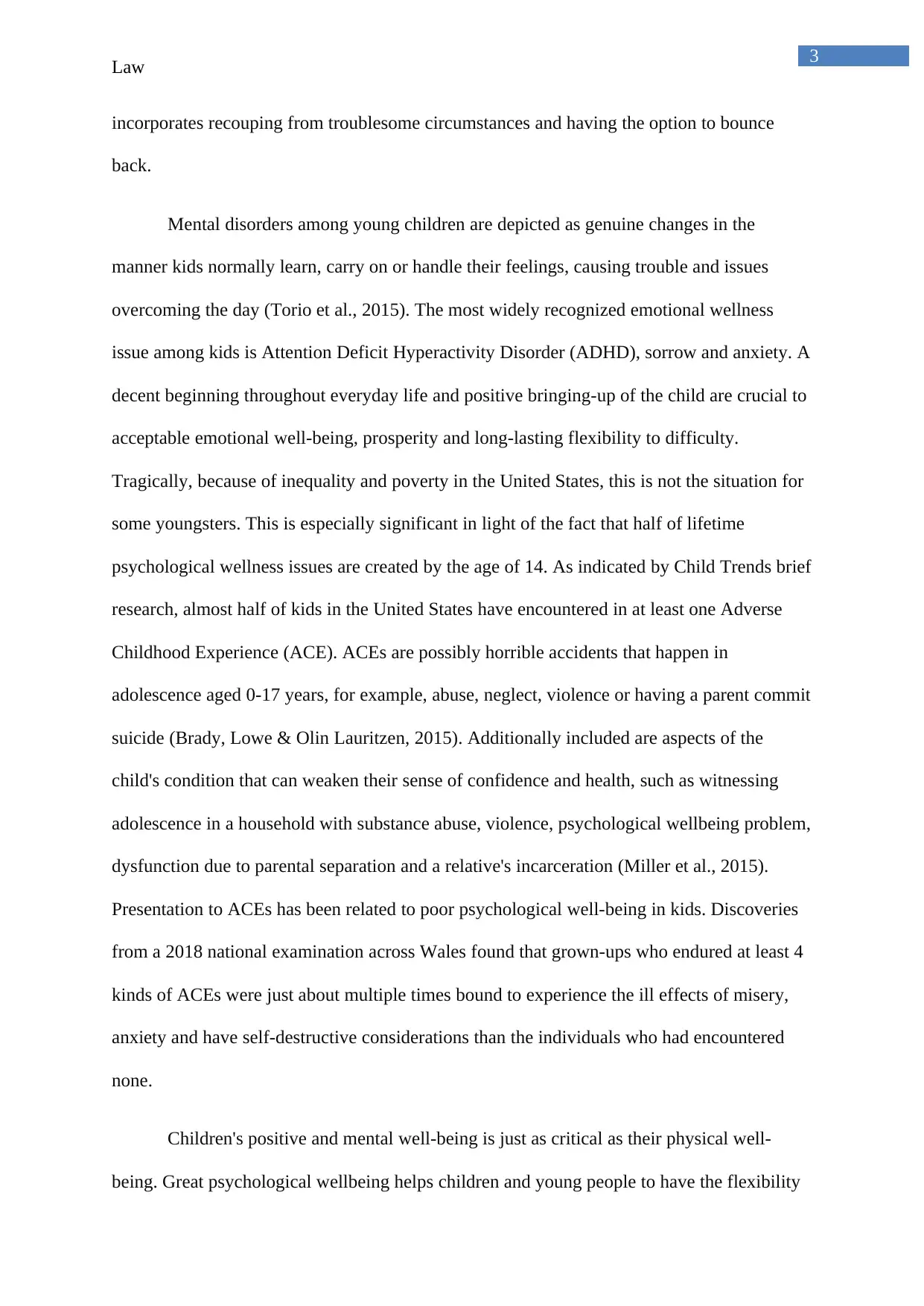
3
Law
incorporates recouping from troublesome circumstances and having the option to bounce
back.
Mental disorders among young children are depicted as genuine changes in the
manner kids normally learn, carry on or handle their feelings, causing trouble and issues
overcoming the day (Torio et al., 2015). The most widely recognized emotional wellness
issue among kids is Attention Deficit Hyperactivity Disorder (ADHD), sorrow and anxiety. A
decent beginning throughout everyday life and positive bringing-up of the child are crucial to
acceptable emotional well-being, prosperity and long-lasting flexibility to difficulty.
Tragically, because of inequality and poverty in the United States, this is not the situation for
some youngsters. This is especially significant in light of the fact that half of lifetime
psychological wellness issues are created by the age of 14. As indicated by Child Trends brief
research, almost half of kids in the United States have encountered in at least one Adverse
Childhood Experience (ACE). ACEs are possibly horrible accidents that happen in
adolescence aged 0-17 years, for example, abuse, neglect, violence or having a parent commit
suicide (Brady, Lowe & Olin Lauritzen, 2015). Additionally included are aspects of the
child's condition that can weaken their sense of confidence and health, such as witnessing
adolescence in a household with substance abuse, violence, psychological wellbeing problem,
dysfunction due to parental separation and a relative's incarceration (Miller et al., 2015).
Presentation to ACEs has been related to poor psychological well-being in kids. Discoveries
from a 2018 national examination across Wales found that grown-ups who endured at least 4
kinds of ACEs were just about multiple times bound to experience the ill effects of misery,
anxiety and have self-destructive considerations than the individuals who had encountered
none.
Children's positive and mental well-being is just as critical as their physical well-
being. Great psychological wellbeing helps children and young people to have the flexibility
Law
incorporates recouping from troublesome circumstances and having the option to bounce
back.
Mental disorders among young children are depicted as genuine changes in the
manner kids normally learn, carry on or handle their feelings, causing trouble and issues
overcoming the day (Torio et al., 2015). The most widely recognized emotional wellness
issue among kids is Attention Deficit Hyperactivity Disorder (ADHD), sorrow and anxiety. A
decent beginning throughout everyday life and positive bringing-up of the child are crucial to
acceptable emotional well-being, prosperity and long-lasting flexibility to difficulty.
Tragically, because of inequality and poverty in the United States, this is not the situation for
some youngsters. This is especially significant in light of the fact that half of lifetime
psychological wellness issues are created by the age of 14. As indicated by Child Trends brief
research, almost half of kids in the United States have encountered in at least one Adverse
Childhood Experience (ACE). ACEs are possibly horrible accidents that happen in
adolescence aged 0-17 years, for example, abuse, neglect, violence or having a parent commit
suicide (Brady, Lowe & Olin Lauritzen, 2015). Additionally included are aspects of the
child's condition that can weaken their sense of confidence and health, such as witnessing
adolescence in a household with substance abuse, violence, psychological wellbeing problem,
dysfunction due to parental separation and a relative's incarceration (Miller et al., 2015).
Presentation to ACEs has been related to poor psychological well-being in kids. Discoveries
from a 2018 national examination across Wales found that grown-ups who endured at least 4
kinds of ACEs were just about multiple times bound to experience the ill effects of misery,
anxiety and have self-destructive considerations than the individuals who had encountered
none.
Children's positive and mental well-being is just as critical as their physical well-
being. Great psychological wellbeing helps children and young people to have the flexibility
Paraphrase This Document
Need a fresh take? Get an instant paraphrase of this document with our AI Paraphraser
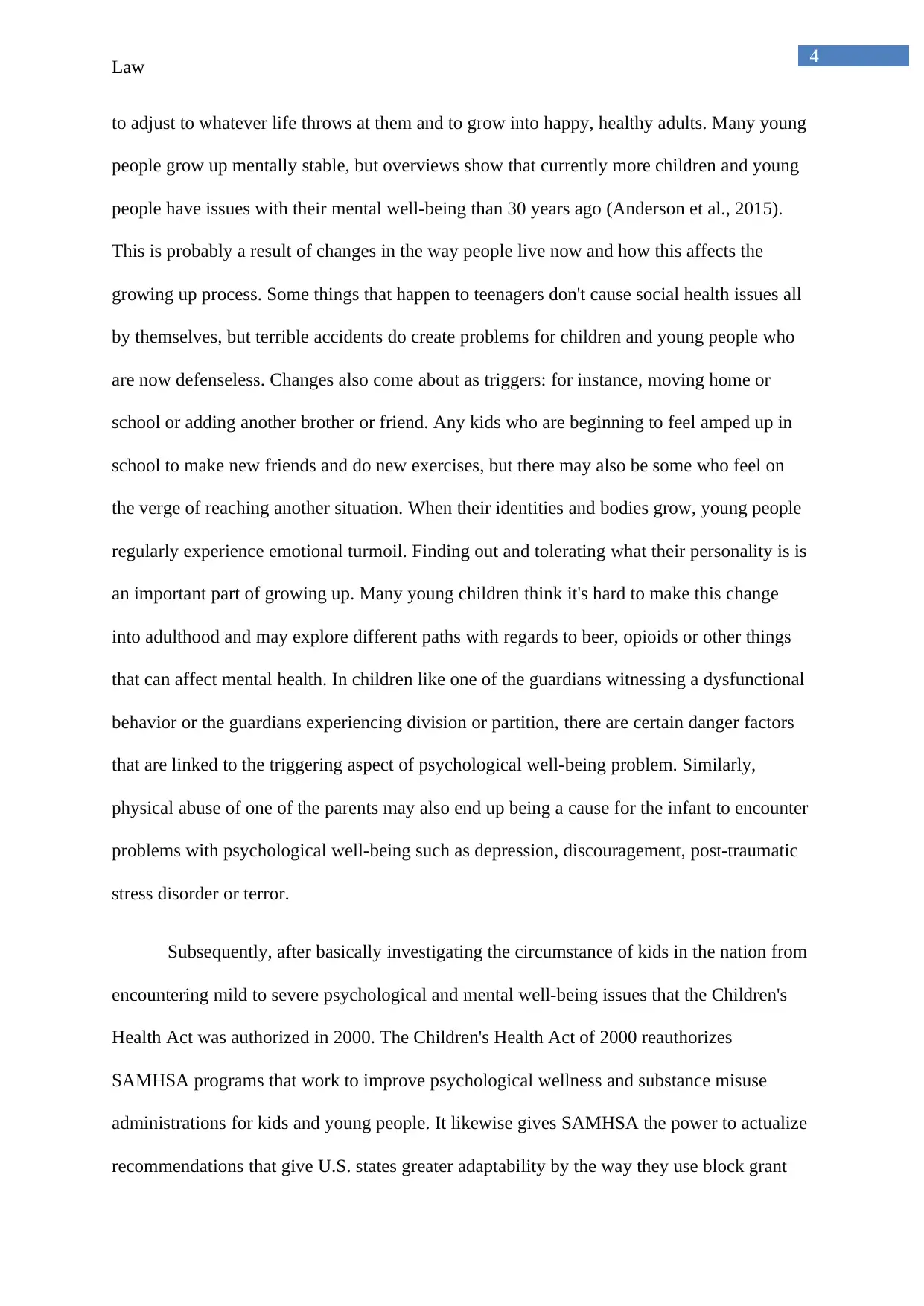
4
Law
to adjust to whatever life throws at them and to grow into happy, healthy adults. Many young
people grow up mentally stable, but overviews show that currently more children and young
people have issues with their mental well-being than 30 years ago (Anderson et al., 2015).
This is probably a result of changes in the way people live now and how this affects the
growing up process. Some things that happen to teenagers don't cause social health issues all
by themselves, but terrible accidents do create problems for children and young people who
are now defenseless. Changes also come about as triggers: for instance, moving home or
school or adding another brother or friend. Any kids who are beginning to feel amped up in
school to make new friends and do new exercises, but there may also be some who feel on
the verge of reaching another situation. When their identities and bodies grow, young people
regularly experience emotional turmoil. Finding out and tolerating what their personality is is
an important part of growing up. Many young children think it's hard to make this change
into adulthood and may explore different paths with regards to beer, opioids or other things
that can affect mental health. In children like one of the guardians witnessing a dysfunctional
behavior or the guardians experiencing division or partition, there are certain danger factors
that are linked to the triggering aspect of psychological well-being problem. Similarly,
physical abuse of one of the parents may also end up being a cause for the infant to encounter
problems with psychological well-being such as depression, discouragement, post-traumatic
stress disorder or terror.
Subsequently, after basically investigating the circumstance of kids in the nation from
encountering mild to severe psychological and mental well-being issues that the Children's
Health Act was authorized in 2000. The Children's Health Act of 2000 reauthorizes
SAMHSA programs that work to improve psychological wellness and substance misuse
administrations for kids and young people. It likewise gives SAMHSA the power to actualize
recommendations that give U.S. states greater adaptability by the way they use block grant
Law
to adjust to whatever life throws at them and to grow into happy, healthy adults. Many young
people grow up mentally stable, but overviews show that currently more children and young
people have issues with their mental well-being than 30 years ago (Anderson et al., 2015).
This is probably a result of changes in the way people live now and how this affects the
growing up process. Some things that happen to teenagers don't cause social health issues all
by themselves, but terrible accidents do create problems for children and young people who
are now defenseless. Changes also come about as triggers: for instance, moving home or
school or adding another brother or friend. Any kids who are beginning to feel amped up in
school to make new friends and do new exercises, but there may also be some who feel on
the verge of reaching another situation. When their identities and bodies grow, young people
regularly experience emotional turmoil. Finding out and tolerating what their personality is is
an important part of growing up. Many young children think it's hard to make this change
into adulthood and may explore different paths with regards to beer, opioids or other things
that can affect mental health. In children like one of the guardians witnessing a dysfunctional
behavior or the guardians experiencing division or partition, there are certain danger factors
that are linked to the triggering aspect of psychological well-being problem. Similarly,
physical abuse of one of the parents may also end up being a cause for the infant to encounter
problems with psychological well-being such as depression, discouragement, post-traumatic
stress disorder or terror.
Subsequently, after basically investigating the circumstance of kids in the nation from
encountering mild to severe psychological and mental well-being issues that the Children's
Health Act was authorized in 2000. The Children's Health Act of 2000 reauthorizes
SAMHSA programs that work to improve psychological wellness and substance misuse
administrations for kids and young people. It likewise gives SAMHSA the power to actualize
recommendations that give U.S. states greater adaptability by the way they use block grant
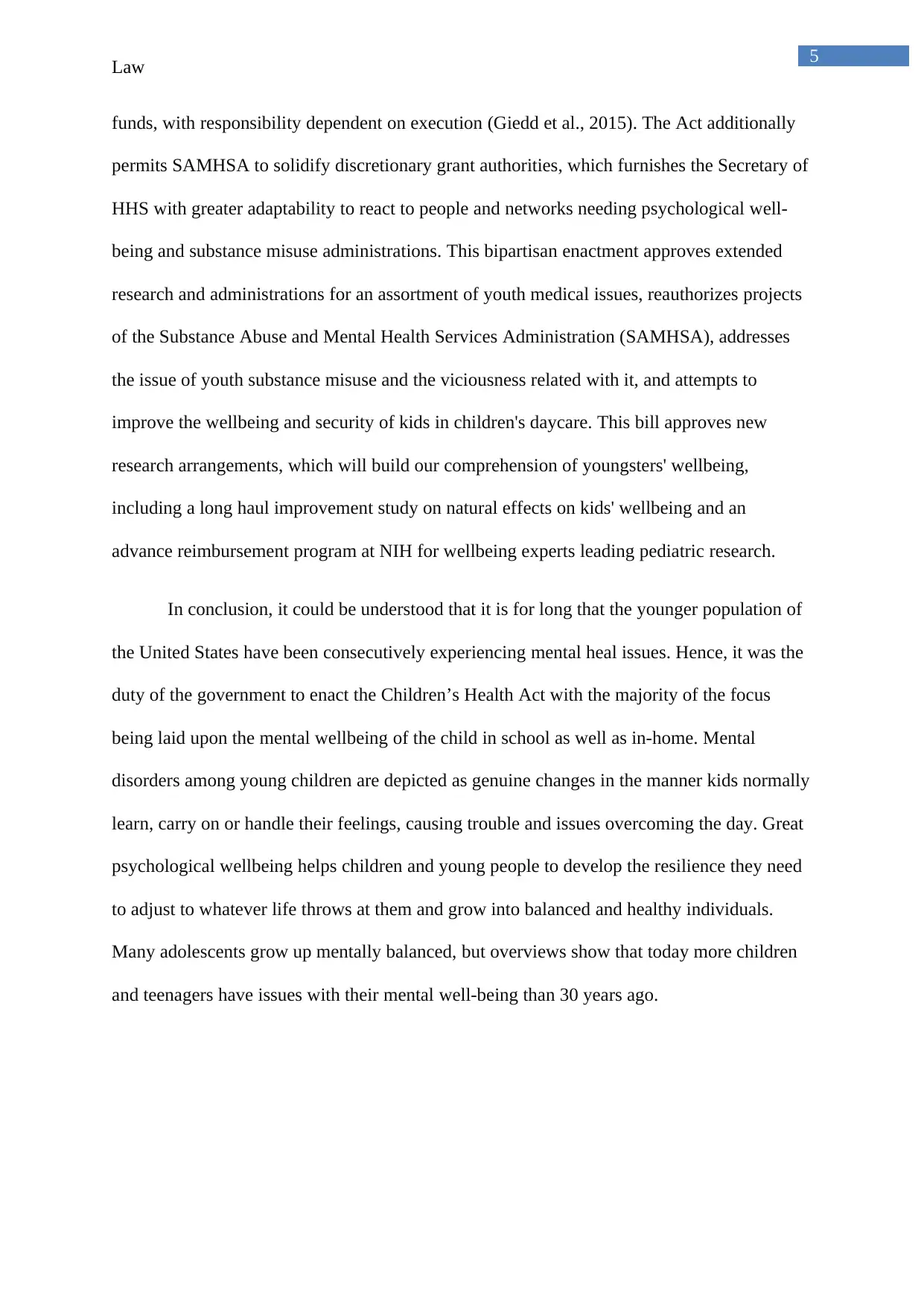
5
Law
funds, with responsibility dependent on execution (Giedd et al., 2015). The Act additionally
permits SAMHSA to solidify discretionary grant authorities, which furnishes the Secretary of
HHS with greater adaptability to react to people and networks needing psychological well-
being and substance misuse administrations. This bipartisan enactment approves extended
research and administrations for an assortment of youth medical issues, reauthorizes projects
of the Substance Abuse and Mental Health Services Administration (SAMHSA), addresses
the issue of youth substance misuse and the viciousness related with it, and attempts to
improve the wellbeing and security of kids in children's daycare. This bill approves new
research arrangements, which will build our comprehension of youngsters' wellbeing,
including a long haul improvement study on natural effects on kids' wellbeing and an
advance reimbursement program at NIH for wellbeing experts leading pediatric research.
In conclusion, it could be understood that it is for long that the younger population of
the United States have been consecutively experiencing mental heal issues. Hence, it was the
duty of the government to enact the Children’s Health Act with the majority of the focus
being laid upon the mental wellbeing of the child in school as well as in-home. Mental
disorders among young children are depicted as genuine changes in the manner kids normally
learn, carry on or handle their feelings, causing trouble and issues overcoming the day. Great
psychological wellbeing helps children and young people to develop the resilience they need
to adjust to whatever life throws at them and grow into balanced and healthy individuals.
Many adolescents grow up mentally balanced, but overviews show that today more children
and teenagers have issues with their mental well-being than 30 years ago.
Law
funds, with responsibility dependent on execution (Giedd et al., 2015). The Act additionally
permits SAMHSA to solidify discretionary grant authorities, which furnishes the Secretary of
HHS with greater adaptability to react to people and networks needing psychological well-
being and substance misuse administrations. This bipartisan enactment approves extended
research and administrations for an assortment of youth medical issues, reauthorizes projects
of the Substance Abuse and Mental Health Services Administration (SAMHSA), addresses
the issue of youth substance misuse and the viciousness related with it, and attempts to
improve the wellbeing and security of kids in children's daycare. This bill approves new
research arrangements, which will build our comprehension of youngsters' wellbeing,
including a long haul improvement study on natural effects on kids' wellbeing and an
advance reimbursement program at NIH for wellbeing experts leading pediatric research.
In conclusion, it could be understood that it is for long that the younger population of
the United States have been consecutively experiencing mental heal issues. Hence, it was the
duty of the government to enact the Children’s Health Act with the majority of the focus
being laid upon the mental wellbeing of the child in school as well as in-home. Mental
disorders among young children are depicted as genuine changes in the manner kids normally
learn, carry on or handle their feelings, causing trouble and issues overcoming the day. Great
psychological wellbeing helps children and young people to develop the resilience they need
to adjust to whatever life throws at them and grow into balanced and healthy individuals.
Many adolescents grow up mentally balanced, but overviews show that today more children
and teenagers have issues with their mental well-being than 30 years ago.
⊘ This is a preview!⊘
Do you want full access?
Subscribe today to unlock all pages.

Trusted by 1+ million students worldwide
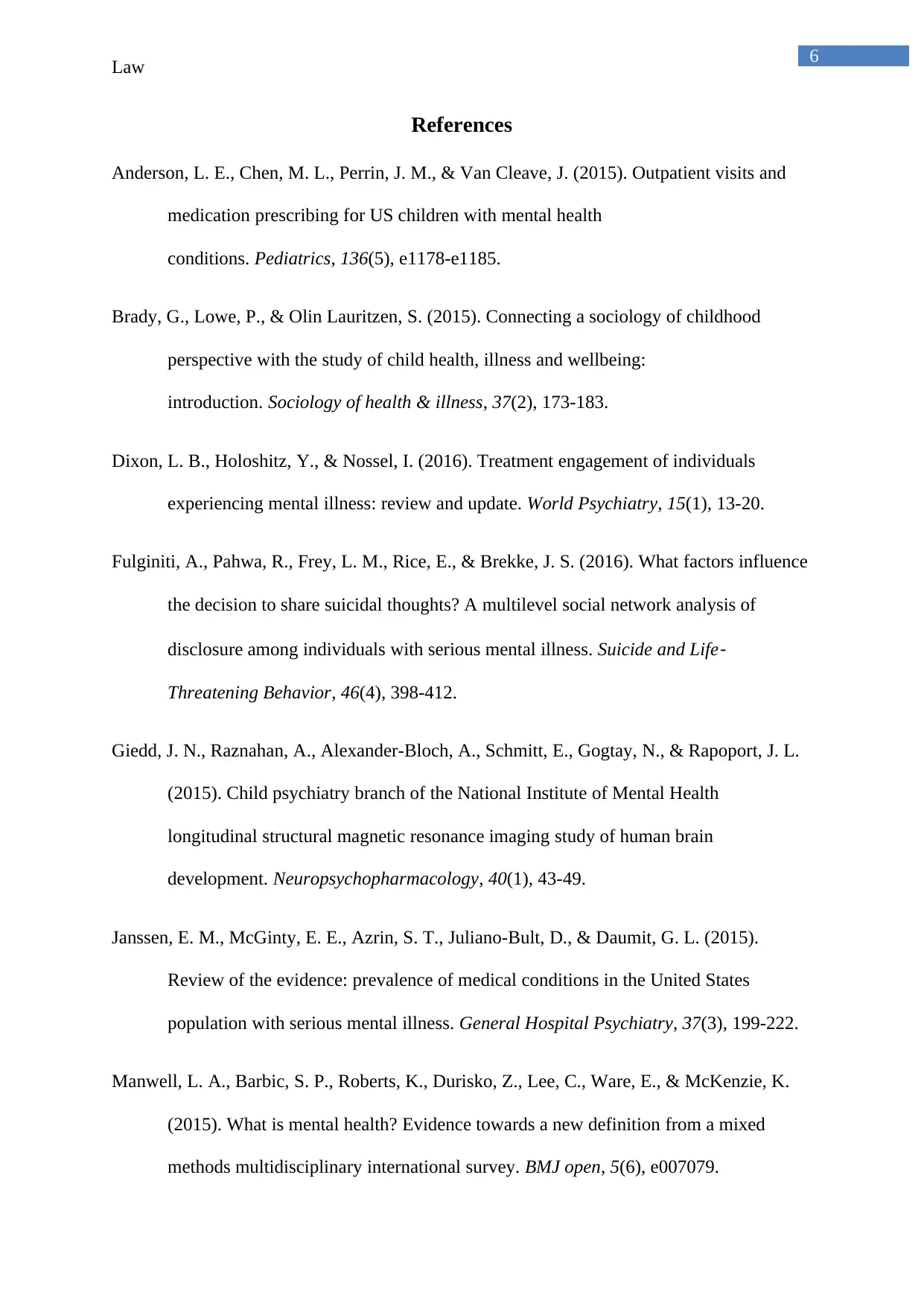
6
Law
References
Anderson, L. E., Chen, M. L., Perrin, J. M., & Van Cleave, J. (2015). Outpatient visits and
medication prescribing for US children with mental health
conditions. Pediatrics, 136(5), e1178-e1185.
Brady, G., Lowe, P., & Olin Lauritzen, S. (2015). Connecting a sociology of childhood
perspective with the study of child health, illness and wellbeing:
introduction. Sociology of health & illness, 37(2), 173-183.
Dixon, L. B., Holoshitz, Y., & Nossel, I. (2016). Treatment engagement of individuals
experiencing mental illness: review and update. World Psychiatry, 15(1), 13-20.
Fulginiti, A., Pahwa, R., Frey, L. M., Rice, E., & Brekke, J. S. (2016). What factors influence
the decision to share suicidal thoughts? A multilevel social network analysis of
disclosure among individuals with serious mental illness. Suicide and Life
‐
Threatening Behavior, 46(4), 398-412.
Giedd, J. N., Raznahan, A., Alexander-Bloch, A., Schmitt, E., Gogtay, N., & Rapoport, J. L.
(2015). Child psychiatry branch of the National Institute of Mental Health
longitudinal structural magnetic resonance imaging study of human brain
development. Neuropsychopharmacology, 40(1), 43-49.
Janssen, E. M., McGinty, E. E., Azrin, S. T., Juliano-Bult, D., & Daumit, G. L. (2015).
Review of the evidence: prevalence of medical conditions in the United States
population with serious mental illness. General Hospital Psychiatry, 37(3), 199-222.
Manwell, L. A., Barbic, S. P., Roberts, K., Durisko, Z., Lee, C., Ware, E., & McKenzie, K.
(2015). What is mental health? Evidence towards a new definition from a mixed
methods multidisciplinary international survey. BMJ open, 5(6), e007079.
Law
References
Anderson, L. E., Chen, M. L., Perrin, J. M., & Van Cleave, J. (2015). Outpatient visits and
medication prescribing for US children with mental health
conditions. Pediatrics, 136(5), e1178-e1185.
Brady, G., Lowe, P., & Olin Lauritzen, S. (2015). Connecting a sociology of childhood
perspective with the study of child health, illness and wellbeing:
introduction. Sociology of health & illness, 37(2), 173-183.
Dixon, L. B., Holoshitz, Y., & Nossel, I. (2016). Treatment engagement of individuals
experiencing mental illness: review and update. World Psychiatry, 15(1), 13-20.
Fulginiti, A., Pahwa, R., Frey, L. M., Rice, E., & Brekke, J. S. (2016). What factors influence
the decision to share suicidal thoughts? A multilevel social network analysis of
disclosure among individuals with serious mental illness. Suicide and Life
‐
Threatening Behavior, 46(4), 398-412.
Giedd, J. N., Raznahan, A., Alexander-Bloch, A., Schmitt, E., Gogtay, N., & Rapoport, J. L.
(2015). Child psychiatry branch of the National Institute of Mental Health
longitudinal structural magnetic resonance imaging study of human brain
development. Neuropsychopharmacology, 40(1), 43-49.
Janssen, E. M., McGinty, E. E., Azrin, S. T., Juliano-Bult, D., & Daumit, G. L. (2015).
Review of the evidence: prevalence of medical conditions in the United States
population with serious mental illness. General Hospital Psychiatry, 37(3), 199-222.
Manwell, L. A., Barbic, S. P., Roberts, K., Durisko, Z., Lee, C., Ware, E., & McKenzie, K.
(2015). What is mental health? Evidence towards a new definition from a mixed
methods multidisciplinary international survey. BMJ open, 5(6), e007079.
Paraphrase This Document
Need a fresh take? Get an instant paraphrase of this document with our AI Paraphraser
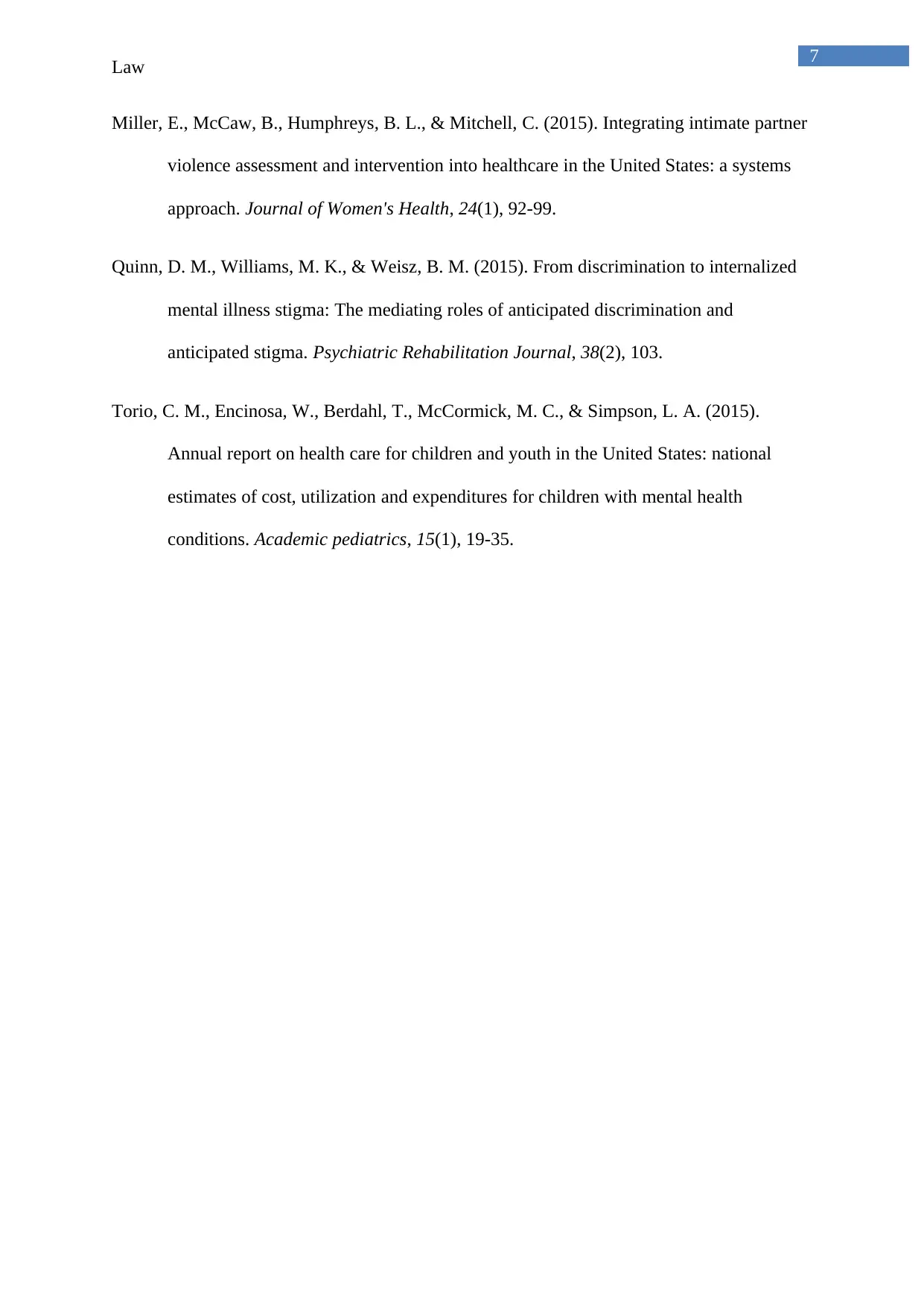
7
Law
Miller, E., McCaw, B., Humphreys, B. L., & Mitchell, C. (2015). Integrating intimate partner
violence assessment and intervention into healthcare in the United States: a systems
approach. Journal of Women's Health, 24(1), 92-99.
Quinn, D. M., Williams, M. K., & Weisz, B. M. (2015). From discrimination to internalized
mental illness stigma: The mediating roles of anticipated discrimination and
anticipated stigma. Psychiatric Rehabilitation Journal, 38(2), 103.
Torio, C. M., Encinosa, W., Berdahl, T., McCormick, M. C., & Simpson, L. A. (2015).
Annual report on health care for children and youth in the United States: national
estimates of cost, utilization and expenditures for children with mental health
conditions. Academic pediatrics, 15(1), 19-35.
Law
Miller, E., McCaw, B., Humphreys, B. L., & Mitchell, C. (2015). Integrating intimate partner
violence assessment and intervention into healthcare in the United States: a systems
approach. Journal of Women's Health, 24(1), 92-99.
Quinn, D. M., Williams, M. K., & Weisz, B. M. (2015). From discrimination to internalized
mental illness stigma: The mediating roles of anticipated discrimination and
anticipated stigma. Psychiatric Rehabilitation Journal, 38(2), 103.
Torio, C. M., Encinosa, W., Berdahl, T., McCormick, M. C., & Simpson, L. A. (2015).
Annual report on health care for children and youth in the United States: national
estimates of cost, utilization and expenditures for children with mental health
conditions. Academic pediatrics, 15(1), 19-35.
1 out of 8
Related Documents
Your All-in-One AI-Powered Toolkit for Academic Success.
+13062052269
info@desklib.com
Available 24*7 on WhatsApp / Email
![[object Object]](/_next/static/media/star-bottom.7253800d.svg)
Unlock your academic potential
Copyright © 2020–2025 A2Z Services. All Rights Reserved. Developed and managed by ZUCOL.





